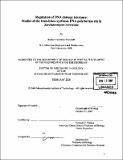Regulation of DNA damage tolerance : studies of the translesion synthesis DNA ploymerase eta in Saccharomyces cerevisiae
Author(s)
Woodruff, Rachel Van Etten
DownloadFull printable version (22.92Mb)
Alternative title
Studies of the translesion synthesis DNA ploymerase eta in Saccharomyces cerevisiae
Other Contributors
Massachusetts Institute of Technology. Dept. of Biology.
Advisor
Graham C. Walker.
Terms of use
Metadata
Show full item recordAbstract
All organisms must control the effects of DNA damage to protect the integrity of their genomes. In addition to DNA repair, this requires DNA damage tolerance pathways, which allow the continuation of essential processes in the presence of DNA damage. One such mechanism is translesion synthesis (TLS), in which a specialized polymerase replicates a damaged DNA template. These studies address the regulation of the eukaryotic TLS polymerase eta, which is particularly important for accurately bypassing UV-induced DNA damage. Here I identify a regulatory domain of Saccharomyces cerevisiae polymerase eta and show that it is essential for pol eta's function. This domain interacts with ubiquitin, and has been named the UBZ (ubiquitin binding zinc finger) domain because its human homolog is a zinc finger. However, results presented here demonstrate that, in S. cerevisiae, neither the sequence nor the functional significance of the zinc finger within the UBZ domain is conserved. I present the first analysis of DNA-association of S. cerevisiae pol eta, demonstrating a UBZ-dependent increase in its chromatin-association in response to DNA damage. These results are consistent with the UBZ domain of S. cerevisiae pol eta forming a zincless finger, similar in structure and function to its human counterpart, and mediating a physical interaction with ubiquitinated PCNA to promote pol eta's association with damaged DNA. Another eukaryotic TLS polymerase is Rev1, which is thought to play a structural role in TLS by binding the other TLS polymerases. In mammals, Rev and pol eta robustly interact. Here, I show that any physical interaction between Rev and pol eta in S. cerevisiae is too weak or conditional to observe by coimmunoprecipitation. (cont.) Finally, I describe a genetic study to elucidate the functional interactions of pol eta with Rev and another TLS polymerase, pol zeta. The results presented here are consistent with TLS during two distinct periods during the cell cycle, with pol eta contributing most to S-phase TLS. Pol eta's complex genetic relationships with the other polymerases show that pol eta generally acts independently, but may cooperate with the other polymerases in a damage-induced pathway. Alternative explanations of the data are also discussed.
Description
Thesis (Ph. D.)--Massachusetts Institute of Technology, Dept. of Biology, 2008. Includes bibliographical references.
Date issued
2008Department
Massachusetts Institute of Technology. Department of BiologyPublisher
Massachusetts Institute of Technology
Keywords
Biology.